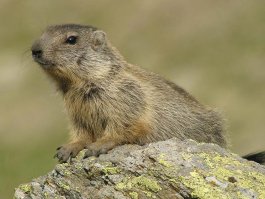|
The
Fanes' saga - Short essays
The marmot
The
European marmot (marmota marmota), in German Murmeltier,
in Ladinian muntagnola, in Italian marmotta,
a rodent belonging to the family of the Sciuridae, is a mammal
very frequent in the alpine and sub-alpine pastures at altitudes
between 1500 and 3000 m, and is well known to all visitors of
our mountains.
| It
is up to 50 cm long, tail excluded, and generally weighs
about 5 kg. Rather heavily built, its short limbs ending
with claws suitable for digging, it can move however with
surprising agility. Its fur, grey to brown, is thick, rough,
and provides a good shelter from the severe mounatin climate.
It lives
in small familiar groups, numbering up to 10-15 individuals,
sometimes grouped into “towns”, where terrain
allows it (up to about 100 individuals per sq.km.). Its
primary needs include both good pasture grounds and the
opportunity to dig wide and comfortable dens, comprising
many rooms and several access and getaway burrows.
|
 |
A
marmot’s winter den, on the contrary, has a single access
burrow, several meters long at times, which is carefully plugged
before hibernating, and a single comfortable room lined with hay.
The marmots’ hibernation lasts from October to April.
A
typical feature of the marmots’ social behaviour is that
of leaving one or more “sentinels”, often standing
up, watching the small flock grazing. If a danger, usually a predator,
is sighted, a sequence of high-pitched whistles recalls everyone
to the den’s safety. It seems that these whistles are coded
according to the type and the imminence of the danger.
All
marmots in the Fanes’ area have been slaughtered (for food!)
by soldiers of both armies during the first World War. The many
animals that can be encountered today, therefore, all come from
repopulations.
In
the Fanes’ saga the marmot represents the symbolic animal,
the tribe’s “totem”, with which the Fanes even
identify themselves. It is possible that this identification took
the move from an ancestral behaviour of the Fanes themselves,
i.e. taking shelter in the caves of their highlands as soon as
enemy was approaching.
|

